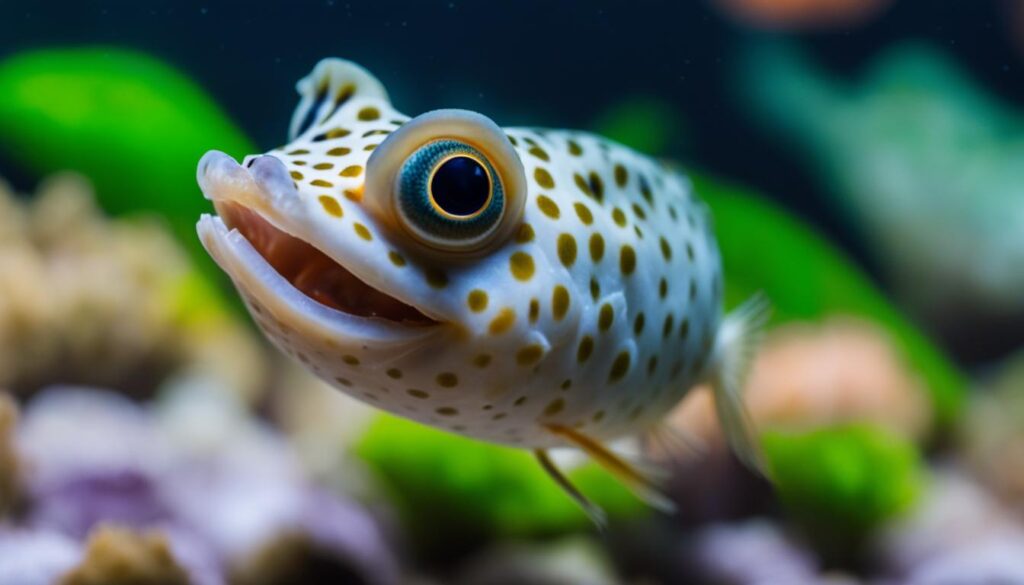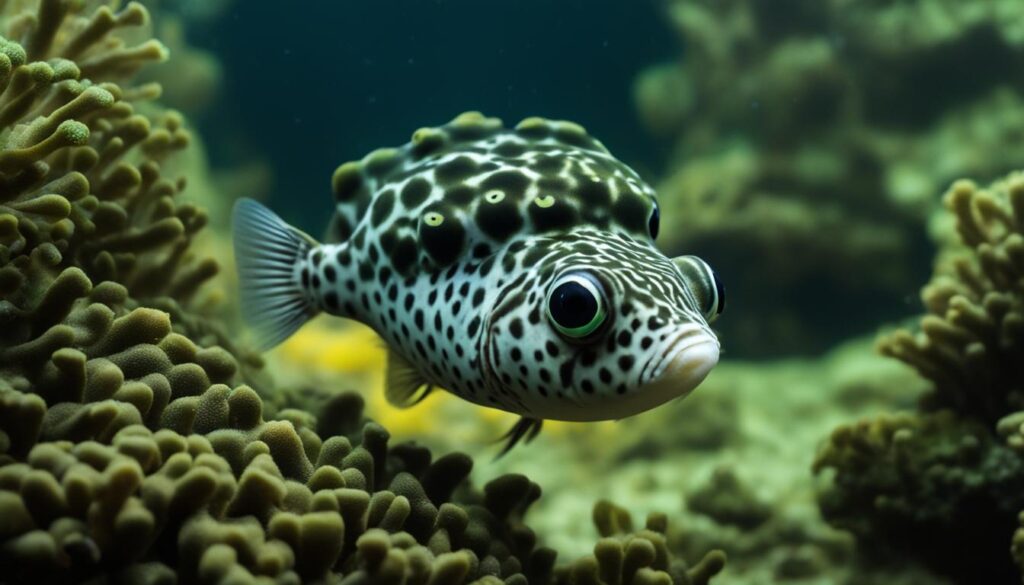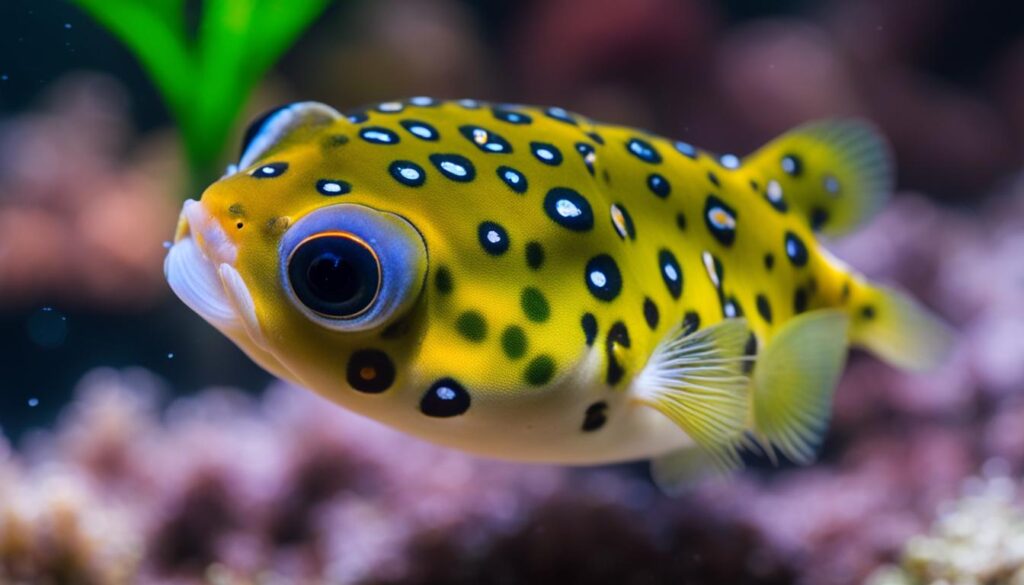Have you ever wondered how to properly care for a pea puffer? Despite their small size, these tiny freshwater pufferfish require specific care to thrive in captivity. Are you ready to discover the essential tips and facts that will ensure your pea puffer’s well-being?
- Pea puffers are the smallest known species of pufferfish, reaching a maximum size of approximately 25mm (0.98 inches).
- These fish thrive in heavily planted aquariums with visual barriers and plenty of hiding places.
- Pea puffers are strict carnivores and require a diet of frozen and live foods.
- They are best kept in a species-only tank due to their aggressive and territorial nature.
- Regular observation and proper tank maintenance are crucial to prevent and treat diseases.
Tank Setup for Pea Puffers
Creating the ideal tank setup for your pea puffers is essential to providing them with a comfortable and stimulating environment. These small but lively freshwater pufferfish thrive in aquariums that mimic their natural habitat. Here are some key elements to consider when setting up a tank for your pea puffers:
Aquascaping
A well-planned aquascape is crucial for the well-being of your pea puffers. They prefer heavily planted aquariums that offer visual barriers and ample hiding places. You can use a variety of aquascaping materials such as driftwood, rocks, and live plants to create a visually appealing and functional setup. Consider incorporating dense vegetation, such as Java Fern and mosses, to provide cover and secure hiding spots for your fish.
Water Flow and Substrate
Pea puffers prefer a slow to medium water flow in their tank. It is advisable to adjust the flow rate of your filter or choose one specifically designed for gentle water movement. Additionally, providing a substrate of fine, soft sand is recommended, as it mimics their natural environment and allows for easy foraging.
Water Quality and Maintenance
Pea puffers are sensitive to water conditions, so it’s essential to maintain high water quality. Regular water changes and adequate filtration are key to ensuring optimal conditions for your fish. Monitoring water parameters such as temperature, pH, and ammonia levels is crucial in preventing stress and maintaining a healthy tank environment.
Incorporating these tank setup tips will help create a safe and stimulating space for your pea puffers to thrive. Let’s move on to the next section to learn more about their feeding requirements.
Feeding Pea Puffers
Pea puffers, also known as Carinotetraodon travancoricus, have specific feeding requirements due to their strict carnivorous nature. To ensure their optimal health and well-being, it is crucial to understand their dietary needs and provide appropriate sustenance.
Pea puffers do not typically accept dry foods such as pellets or flakes, and therefore, a diet consisting of frozen and live foods is essential. Providing a variety of food sources is vital to ensure they receive all the necessary nutrients.
Some suitable foods for feeding pea puffers include:
- Frozen bloodworms
- Brine shrimp
- Live snails
A varied diet not only provides essential nutrients but also stimulates their natural hunting behavior. Feeding small amounts multiple times a day is recommended since pea puffers have small stomachs and can easily overeat.
It’s essential to monitor their feeding habits and adjust the quantity accordingly to maintain their overall health. Paying attention to their dietary needs will ensure the longevity and vitality of these captivating fish.

Tank Mates and Diseases
When it comes to tank mates, pea puffers are best kept in a species-only tank. These small pufferfish can be aggressive and territorial, and they are known to nip at the fins of other fish, potentially causing harm. To prevent any conflicts, it is recommended to keep pea puffers in a tank by themselves.
In addition to their aggressive nature, pea puffers are also susceptible to certain diseases. Bacterial infections and parasitic infections are common concerns for these fish. To maintain their health and well-being, it is crucial to focus on proper tank maintenance, water quality, and regular observation of their behavior.
Quarantine New Additions
Before introducing any new fish or plants to the tank, it is essential to quarantine them first. This practice helps prevent the introduction of diseases that can harm your existing pea puffers. By establishing a quarantine tank and closely monitoring the new additions for signs of illness, you can protect the well-being of your entire aquarium population.

Preventing and Treating Diseases
To maintain the health of your pea puffers, it is crucial to follow proper tank care practices. This includes regular water testing and changing, maintaining appropriate filtration, and ensuring optimal water conditions. Additionally, observing your pea puffers for any signs of illness, such as changes in behavior, loss of appetite, or physical abnormalities, can help identify and treat diseases at an early stage.
Proper tank maintenance, water quality, and regular observation play a crucial role in preventing and treating diseases in pea puffers.
Conclusion
Pea puffers, also known as dwarf puffers, are fascinating and unique freshwater puffer fish that require specific care to thrive in captivity. By providing a suitable tank setup, feeding them a varied diet, and keeping them in a species-only tank, you can ensure the health and well-being of these tiny pufferfish.
It is important to be aware of the vulnerability of pea puffers in the wild and consider supporting responsible breeding practices. Breeding pea puffers in captivity not only helps preserve the species but also ensures a sustainable population in the aquarium trade.
With proper care and attention, pea puffers can live for many years and provide endless enjoyment for their owners. Their playful personalities and vibrant colors make them a popular choice for aquarists of all levels of experience. Whether you’re a beginner or an experienced hobbyist, pea puffers are sure to bring joy and fascination to your aquarium.

